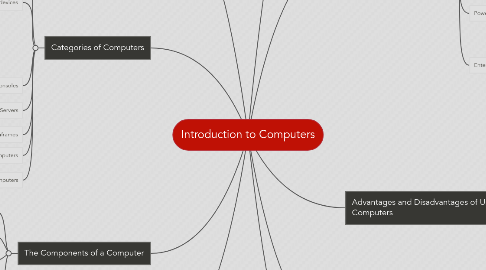
1. Output Device
1.1. Hardware component that conveys information to one or more people
2. Categories of Computers
2.1. Personal computers
2.1.1. perform all of its input, processing, output, and storage activities by itself
2.2. Mobile computers and mobile devices
2.2.1. Notebook computer
2.2.2. Tablet PC
2.2.3. Smart phone
2.2.4. PDA
2.2.5. Handheld computer
2.2.6. Portable media player
2.2.7. Digital camera
2.3. Game consoles
2.3.1. mobile computing device designed for play video games
2.4. Servers
2.4.1. controls access to the hardware, software, and other resources on a network
2.5. Mainframes
2.5.1. a large, expensive, powerful computer
2.6. Supercomputers
2.6.1. the fastest, most powerful computer
2.7. Embedded computers
2.7.1. a special-purpose computer that functions as a component in a larger product
3. The Components of a Computer
3.1. Input Device
3.1.1. Allows you to enter data and instructions into a computer
3.2. System Unit
3.2.1. Case that contains the electronic components of the computer that are used to process data
3.3. Storage Device
3.3.1. Holds data, instructions, and information for future use
3.4. Communications Device
3.4.1. Enables a computer to send and receive data, instruction, and information to and from one or more computers or mobile devices
4. Computer Software
4.1. A programmer develops software or writes the instructions that direct the computer to process data into information
4.2. Software / program
4.2.1. System Software
4.2.2. Application Software
4.3. Installing
4.3.1. process of setting up software to work with the hardware
5. Small Office / Home Office User
5.1. Look up information
5.2. Send and receive e-mail messages
5.3. Make telephone calls
6. Type of Computer Users
6.1. Home User
6.1.1. Personal financial management
6.1.2. Web access
6.1.3. Communications
6.1.4. Entertainment
6.2. Mobile User
6.2.1. Connect to other computers on a network or the Internet
6.2.2. Transfer information
6.2.3. Play video games
6.2.4. Listen to music
6.2.5. Watch movies
6.3. Power User
6.3.1. Work with multimedia
6.3.2. Use industry-specific software
6.4. Enterprise User
6.4.1. Communicate among employees
6.4.2. Process high volumes of transactions
6.4.3. Blog
7. Advantages and Disadvantages of Using Computers
7.1. Advantages of Using Computers
7.1.1. Speed
7.1.2. Relibility
7.1.3. Consistency
7.1.4. Storage
7.1.5. Communications
7.2. Disadvantages of Using Computers
7.2.1. Health Risks
7.2.2. Violation of Privacy
7.2.3. Public Safety
7.2.4. Impact on Labor Force
7.2.5. Impact on Environment
8. Networks and the Internet
8.1. Networks
8.1.1. A collection of computers and devices connected together
8.2. Internet
8.2.1. A worldwide collection of networks
